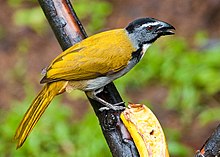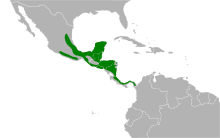Black-headed saltator
| Black-headed saltator | |
|---|---|

| |
| At Cordillera de Talamanca, Costa Rica | |
| Scientific classification | |
| Domain: | Eukaryota |
| Kingdom: | Animalia |
| Phylum: | Chordata |
| Class: | Aves |
| Order: | Passeriformes |
| Family: | Thraupidae |
| Genus: | Saltator |
| Species: | S. atriceps
|
| Binomial name | |
| Saltator atriceps (Lesson, 1832)
| |

| |

The black-headed saltator (Saltator atriceps) is a seed-eating bird in the tanager family Thraupidae. It breeds from central Mexico to eastern Panama.
This bird is on average 24 cm (9.4 in) long and weighs 85 g (3.0 oz). The adult has a slate-grey head with a whitish supercilium. The upperparts are yellowish green, the underparts are pale grey, and the throat is white edged with black. The thick convex bill is black and the legs are brown. Young birds are duller and have mottling on the breast and brown markings on the underparts. This species is similar to the buff-throated saltator but is larger and has a darker head and paler under parts with a yellow patch on the throat.
The common call is a raucous deeeer. The song is a loud scratchy cher cher jur jur weeee, often given by males as a duet.
The black-headed saltator is a species of dense vegetation. The black-headed saltator feeds on fruit,[a] buds, nectar, and slow-moving insects. It forages at low and mid-levels, sometimes with mixed species flocks.
The two black-marked pale blue eggs per clutch measure some 24–34 mm (0.94–1.34 in) long by about 18–23.5 mm (0.71–0.93 in) wide and weigh about 4.9–5.5 g (0.17–0.19 oz) each.[b] They are laid in a bulky grass-lined cup nesting up to 3 m (9.8 ft) high in a thicket between April and July.
Footnotes[edit]
- ^ e.g. of Cymbopetalum mayanum (Annonaceae). [2]
- ^ i.e. large among Saltator eggs.[3] A specimen measuring 36.2 mm (1.43 in) long and 18.7 mm (0.74 in) wide seems to have an abnormal shape.
References[edit]
- ^ BirdLife International (2016). "Saltator atriceps". IUCN Red List of Threatened Species. 2016: e.T22723869A94837548. doi:10.2305/IUCN.UK.2016-3.RLTS.T22723869A94837548.en. Retrieved 11 November 2021.
- ^ Foster 2007.
- ^ Echeverry-Galvis & Córdoba-Córdoba 2006.
- Echeverry-Galvis, María Ángela; Córdoba-Córdoba, Sergio (2006). "Descripción del huevo del saltátor collarejo (Saltator cinctus) y comentarios preliminares sobre huevos del género Saltator" [Description of the egg of the Masked Saltator (S. cinctus) and preliminary comments on the eggs of the genus Saltator] (PDF). Boletín de la Sociedad Antioqueña de Ornitología (in Spanish). 16 (1): 76–84.
- Foster, Mercedes S. (2007). "The potential of fruiting trees to enhance converted habitats for migrating birds in southern Mexico". Bird Conservation International. 17 (1): 45–61. doi:10.1017/S0959270906000554.PDF fulltext
- Hellack, J.J.; Schnell, G.D. (1977). "Phenetic analysis of the subfamily Cardinalinae using external and skeletal characteristics". Wilson Bulletin. 89: 130–148.
- Stiles, G.; Skutch, A.F. (1989). A Guide to the Birds of Costa Rica. Comstock. ISBN 0-8014-9600-4.
External links[edit]
- BirdLife species factsheet for Saltator atriceps
- "Saltator atriceps". Avibase.
- "Black-headed saltator media". Internet Bird Collection.
- Black-headed saltator photo gallery at VIREO (Drexel University)
- Black-headed saltator species account at Neotropical Birds (Cornell Lab of Ornithology)
- Interactive range map of Saltator atriceps at IUCN Red List maps
- Audio recordings of Black-headed saltator on Xeno-canto.
- Saltator atriceps in Field Guide: Birds of the World on Flickr

